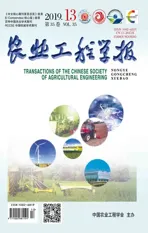十八胺化学改性下壤土的斥水性与入渗性能研究
2019-08-23吴珺华刘嘉铭王茂胜
吴珺华,林 辉,刘嘉铭,王茂胜,杨 松
十八胺化学改性下壤土的斥水性与入渗性能研究
吴珺华1,林 辉1,刘嘉铭1,王茂胜1,杨 松2※
(1. 南昌航空大学土木建筑学院,南昌 330063;2. 云南农业大学水利学院,昆明 650201)
以壤土为研究对象,将十八胺基伯胺作为斥水剂掺入天然风干重塑壤土中,配置了不同十八烷基伯胺含量和初始含水率的改性试样,采用滴水穿透时间法测定了改性壤土的斥水等级,提出并获得了改性壤土的临界含水率,分析了十八烷基伯胺含量、壤土斥水等级、初始含水率的关系。在此基础上,采用全自动三轴渗透仪,开展了改性壤土在不同水头差作用下的渗透试验,揭示了不同斥水等级壤土的入渗性能,获得了改性壤土的稳定入渗率。结果表明:十八烷基伯胺含量和土壤含水率是影响土壤斥水性的重要因素。十八烷基伯胺含量越高,土壤斥水等级越大,上限含水率越低,而下限含水率越高。土壤斥水等级相同时,初始入渗速率受水头差影响较小,如十八胺基伯胺质量分数为0.6%的土壤,20和60 kPa水头差条件下其初始入渗速率分别为0.210和0.238 cm/s;入渗持续一段时间后,入渗速率突然降低,降至0.005 cm/s,进入稳定入渗阶段。土壤斥水性越强,稳定入渗速率和稳定入渗率均呈下降趋势,壤土防渗效果越好。起始出渗时间随水头差的增大而减小,随土壤斥水性的增大而增大。上述研究成果可为斥水性土壤应用于土木水利工程领域提供试验基础。
土壤;渗透性;含水率;斥水性;十八烷基伯胺
0 引 言
亲水性土壤可以在非饱和状态与饱和状态之间相互转换[1]。斥水土壤由于水分难以迅速铺展,水分不易入渗,难以直接转换[2]。这一特性对地表径流、地表水入渗和蒸发、包气带水气运移、植被根系水吸附、地下水环境等具有重要影响[3-4]。具有斥水性的土壤,其导水率和入渗率比亲水性土壤的要小,入渗能力降低[5];土壤内部水分不易流出,导致土壤内外水力差异[6-7],直接影响农作物的正常生长[8];水分侧向运移及不规则分布极大影响着土壤水分运移过程,会导致作物水分胁迫[9]和作物营养胁迫”[10]等不利于农作物生长问题的出现。目前关于土壤斥水性的研究成果主要集中在农业科学等领域,研究对象为天然斥水性的土壤,重点集中在如何减小和消除土壤斥水性带来的负面影响,而针对重塑斥水性土壤的研究鲜见报道。在土木水利工程领域,往往由于亲水土壤的入渗性能导致渗透变形,在外界水压力作用下通过土壤孔隙产生渗透力,出现管涌、流土等入渗破坏现象[11];孔隙水的排出和流入导致土壤孔隙重新分布,产生渗透变形,土壤内部应力重新调整,出现地面变形[12]、边坡失稳[13]、水流渗漏[14]、地表水和地下水污染[15-16]等工程灾害。现有防渗技术以阻断土壤部分渗流路径为主[17],但土壤亲水性对土木水利工程的影响并未引起足够重视,防渗长期性无法保证[18]。随着中国“一带一路”战略性目标的逐步实施,诸多相关地区将不可避免地遇到与水有关的工程安全问题,如土坡滑坍、渗透破坏、地表沉降、污水污染等,这些都涉及到土壤的渗流特性。
常见改性方式主要有物理改性[19-21]、化学改性[22-25]和生物改性[26-28]。化学改性主要是采用表面活性剂对土颗粒表面进行处理,达到改变土颗粒与溶剂相互作用的目的。化学改性在诸多学科应用广泛,如某些憎水、憎油材料的制成。在土木水利工程领域,土壤通常被视为亲水性材料。如果能够通过化学改性方法对其进行处理使其具有斥水性,那么由土壤亲水性引发的各种工程问题可迎刃而解。目前研究表明,土壤斥水性除了与斥水剂类型[29]有关外,还与土壤含水率[30]、密实度[31]、温度[32]等相关。本文采用化学改性的方法,制得不同十八烷基伯胺(简称十八烷,下同)含量和初始含水率的试样,探究十八烷基伯胺含量、初始含水率对改性土壤斥水度的影响。在此基础上,采用全自动三轴渗透仪,开展改性壤土在不同围压、不同水头差作用下的渗透试验,探究改性土壤对渗流的影响,并获得改性壤土稳定入渗率的变化规律。
1 材料与方法
1.1 试验材料
试验用土取自云南省昆明市盘龙区黑龙潭附近地下40 cm埋深处的土壤,风干碾碎过2 mm筛后备用。壤土的相对密度2.71,天然干密度1.35 g/cm3,最大干密度1.5 g/cm3,最优含水率质量分数30.8%,塑限29.5%,液限62.7%,塑性指数33.2。采用丹东百特仪器有限公司生产的BT-9300ST型激光粒度分布仪测定其颗粒级配曲线见图1,其中粒径<0.002 mm、0.002~<0.02 mm和0.02~2 mm的土壤颗粒质量占比分别为18.46%、41.67%和39.87%。根据国际土壤质地三角形分类法可知,试验用土为壤土。经XRD衍射图知壤土主要矿物有石英(质量分数34.0%)、赤铁矿(6.3%)、铁氧化物(9.4%)、高岭石(10.2%)、三水铝矿(24.3%)和白云母(15.7%)。
斥水剂为十八烷基伯胺(CH3(CH2)16CH2NH2)。将十八烷基伯胺碾碎至细颗粒状后备用。辅助材料和设备主要有:去离子水、电烘箱、烧杯、搅拌器、滴定管及防护材料等。
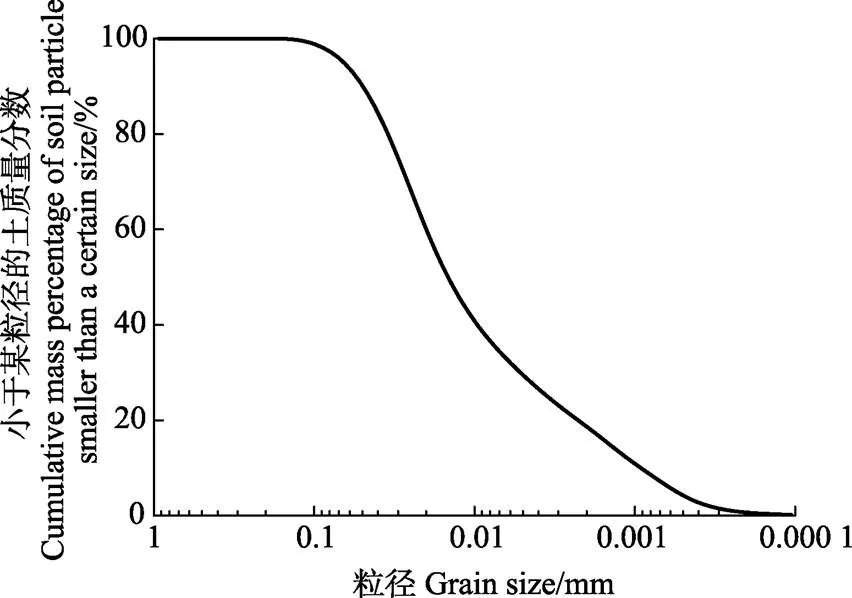
图1 壤土颗粒级配曲线
1.2 初始含水率不同的改性壤土试样制备及试验
将十八烷基伯胺与土壤按不同质量比搅拌均匀后放置75 ℃烘箱中,每隔2 h取出搅拌均匀后再放入烘箱,共搅拌4次,获得十八伯胺含量不同的改性土壤,制备5组不同斥水度的改性土壤。采用喷雾器对斥水土壤进行增湿。试样初始为干燥状态,喷洒一定水量搅拌均匀后,取部分土样密封24 h。每组共制备16种不同初始含水率试样,采用滴水穿透时间法(water drop penetration time,WDPT)测定相应的滴水穿透时间,同时将未滴定检测部分的试样进行含水率试验,相应的含水率见表1。
1.3 渗透试验的试样制备及试验过程
目前斥水土壤的入渗研究主要集中在土壤斥水性对水分运移规律的影响方面[33],研究方法以室内土柱试验[34]和现场入渗试验[35]为主,未考虑高水头和围压下斥水土壤的渗流特性。据此采用南京土壤仪器厂生产的全自动三轴渗透系统进行渗透试验。该系统可自动控制进出试样水量,并实时监测记录流量,最大渗流量为480 mL,精度为0.01 mL。为获得不同斥水程度试样的入渗性能,根据《土工试验方法标准》(GB/T 50123-1999)中三轴试样制备方法分别制备了6组改性壤土试样,每组3个试样,用以开展渗透水头差(试样上下面施加不同水头,模拟工程水头差)分别为20、40和60 kPa的渗透试验。为保证试样与橡胶膜贴合紧密,试验围压恒定为100 kPa。试样为圆柱样(Ф3.91 cm´H8 cm),初始干密度为1.35 g/cm3,初始含水率控制在3.2%±0.2%。试验前先将进水管和出水管中气体完全排出。试验时水通过进液装置从试样底部进入,流经试样后从顶部排出,进水流量和出水流量由流量传感器自动采集。每次渗透试验完成后,需将去离子水补回至储液容器内。有2点需要说明:1)试样斥水度的增大会导致试样抗渗能力增强,其内部被水穿透的实际过水面积越小,导致单位时间内通过试样的水流量越小,故其入渗率逐渐减小;2)有压渗流试验中,试样初始为非饱和状态。水头差越大,试样饱和度越高,但均无法使试样达到完全饱和状态,因此其入渗率与水头差有关,而且未掺十八烷基伯胺的试样入渗率在不同水头差下也存在差异。可以看出,试样的稳定入渗率受斥水度和水头差的共同影响,数值上均要小于饱和导水率。由于本文重点分析十八烷基伯胺含量对改性壤土入渗率的影响,且稳定入渗时满足层流条件,故本文采用达西定律来计算稳定入渗率(式(1)),其中过水断面面积取试样横截面积(即为常数),以探究稳定入渗率与十八烷基伯胺含量的关系。
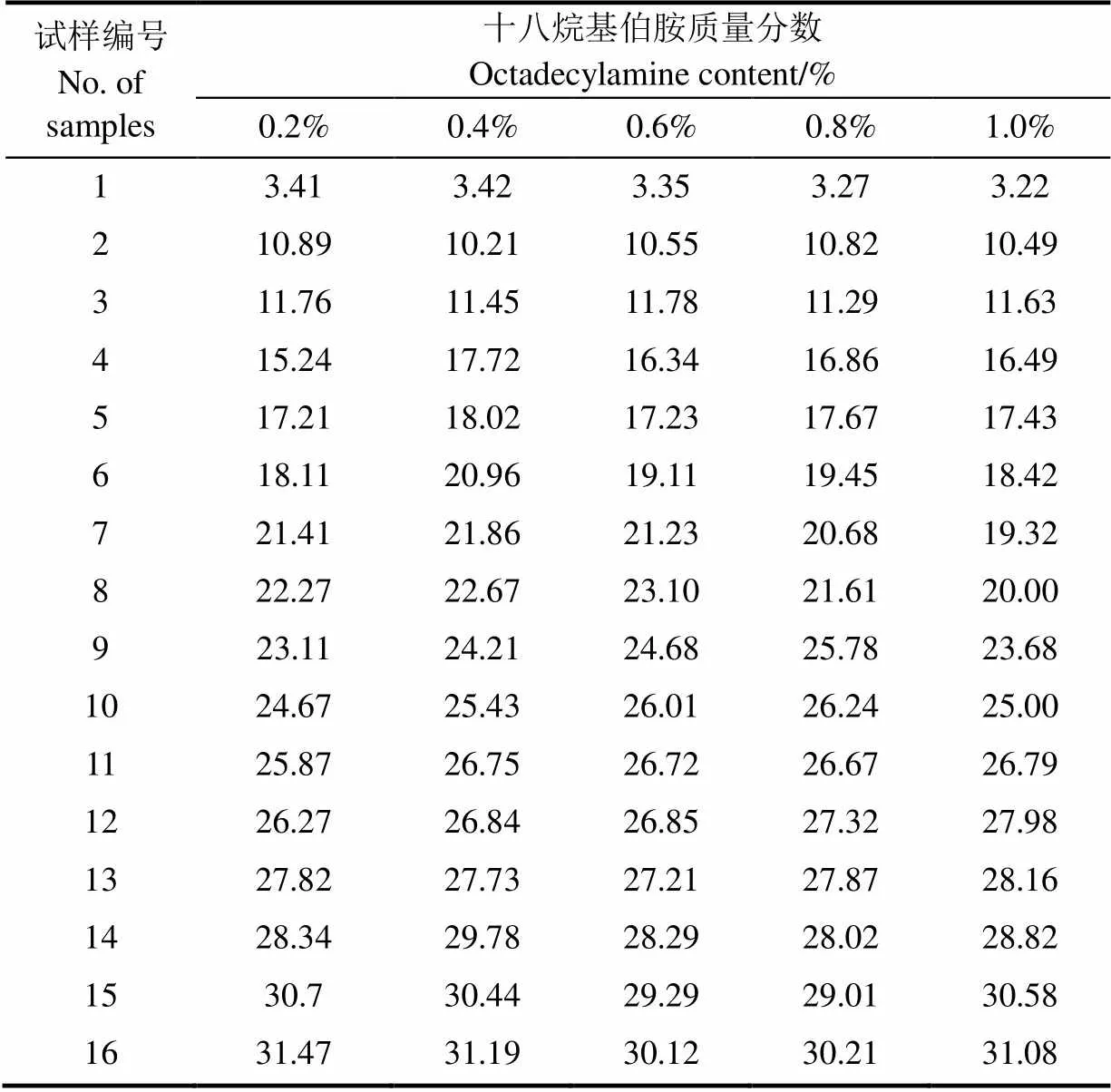
表1 用于临界含水率试验的试样的初始含水率
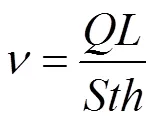
式中为入渗率,cm/s;为流量,透过某横截面积的水量,mL;为试样渗透路径长度,cm;为试样横截面积,cm2;为流量渗透试样所需时间,s;为作用于试样渗透路径长度上的水位差,cm。
1.4 斥水度测定与评价标准
采用滴水穿透时间法来测定改性壤土的斥水度。滴水穿透时间法斥水度评价标准是根据滴水入渗土壤时间的不同将斥水等级分为无(<5 s)、轻微(5 s≤<60 s)、中等(60 s≤<600 s)、严重(600 s≤<3 600 s)和极度(≥3 600 s)5个等级[36]。为降低制样不均匀性的影响,在试样表面选取3处(正三角形分布,间距4 cm)测定滴水穿透时间。每滴水量为0.05 mL,每处滴水5滴,共计0.25 mL,取3处滴水穿透时间平均值作为最终结果。整个试验过程中温度控制在(24 ± 1)℃,湿度控制在64% ± 2%。
2 结果与分析
2.1 初始含水率对改性土壤斥水性能的影响
图2为不同初始含水率下改性壤土的滴水穿透时间变化情况。可以看出,十八烷基伯胺质量分数为0.2%和0.4%的壤土,当含水率质量分数低于12%时,滴水穿透时间均小于5 s,表现出亲水性;含水率质量分数继续增至21%时,其滴水穿透时间迅速增至3 611和4 012 s,即斥水等级由无斥水快速升至极度斥水,增加速率基本一致;含水率质量分数在21%~25%之间的壤土滴水穿透时间均大于3 600 s,斥水等级稳定在极度;含水率质量分数从25%增至32%(饱和)时,其斥水等级均由极度迅速降至无,下降速率基本一致。十八烷基伯胺质量分数为0.6%和0.8%的壤土,天然风干状态下的滴水穿透时间为731和2 584 s,即表现出严重的斥水等级。随着含水率的增加,滴水穿透时间迅速增加,最大增至9 345(初始含水率质量分数为23.1%)和12 364 s(初始含水率质量分数为21.6%),斥水等级为极度;随后滴水穿透时间迅速降低,至饱和状态时斥水性完全消失。十八烷基伯胺质量分数为1.0%的壤土,天然风干状态下的滴水穿透时间为4 886 s,已达到极度斥水等级。随着含水率的增加,滴水穿透时间亦迅速增加,最大值甚至超过18 000 s(初始含水率质量分数为19.3%、20.0%和23.7%),斥水等级均为极度;当含水率质量分数增至26.8%时,滴水穿透时间迅速降至9 346 s,随后快速降低,至饱和状态时斥水性完全消失。
可以看出,除十八烷基伯胺含量外,土壤含水率是影响土壤斥水性的重要因素。笔者将土壤由无斥水达到轻微斥水等级时的起始含水率称为上限含水率;由最高斥水等级降至无斥水等级时的起始含水率称为下限含水率。上限含水率和下限含水率统称为临界含水率。当土壤含水率在上限含水率与下限含水率之间变化时,其斥水性亦会有显著变化,寻找不同斥水程度土壤的上限与下限含水率具有重要意义。就本试验结果而言,十八烷基伯胺质量分数为0.2%和0.4%的壤土,其上限含水率质量分数分别为11.1%和10.8%,下限含水率质量分数分别为23.9%和24.1%;十八烷基伯胺质量分数为0.6%、0.8%和1.0%的壤土,其上限含水率质量分数可取相应的天然风干含水率,分别为3.5%、2.8%和2.0%,下限含水率质量分数分别为26.3%、27.1%和27.3%。相同条件下,土壤密实度越大,意味着其内部孔隙越小,水分越难入渗;含水率越大,土壤内部孔隙逐渐被水充填。一旦孔隙水全部贯通形成连续通道,此时外界水体可经由内部连续通道自由出入,纵使土壤颗粒具有斥水性,亦无法阻止渗流发生。随着初始含水率的增加,土壤的斥水性也逐渐变化,其变化规律基本符合Li等[37-38]的研究成果。

图2 不同初始含水率和十八烷基伯胺含量下壤土的滴水穿透时间和斥水等级
将临界含水率与十八烷基伯胺含量的关系绘于图3,若壤土含水率与十八烷基伯胺含量落在阴影区域内,意味着此时壤土具有较好的斥水性,越接近阴影区域形心,斥水性越好。要使壤土斥水性长期稳定,需合理控制壤土含水率和十八烷基伯胺含量。就本次试验结果而言,十八烷基伯胺含量越大,壤土斥水等级越高,当其含量达到一定值时,壤土斥水等级已达到极度。这表明,十八烷基伯胺含量存在一最优值,既能满足斥水等级要求,又能节约用量,性价比最好。根据本试验结果认为,十八烷基伯胺质量分数为1.0%的壤土,在含水率为0~26.8%范围内皆处于极度斥水等级,较其他组十八烷基伯胺含量的斥水壤土变化范围广,稳定性好,其斥水性能最为合理。
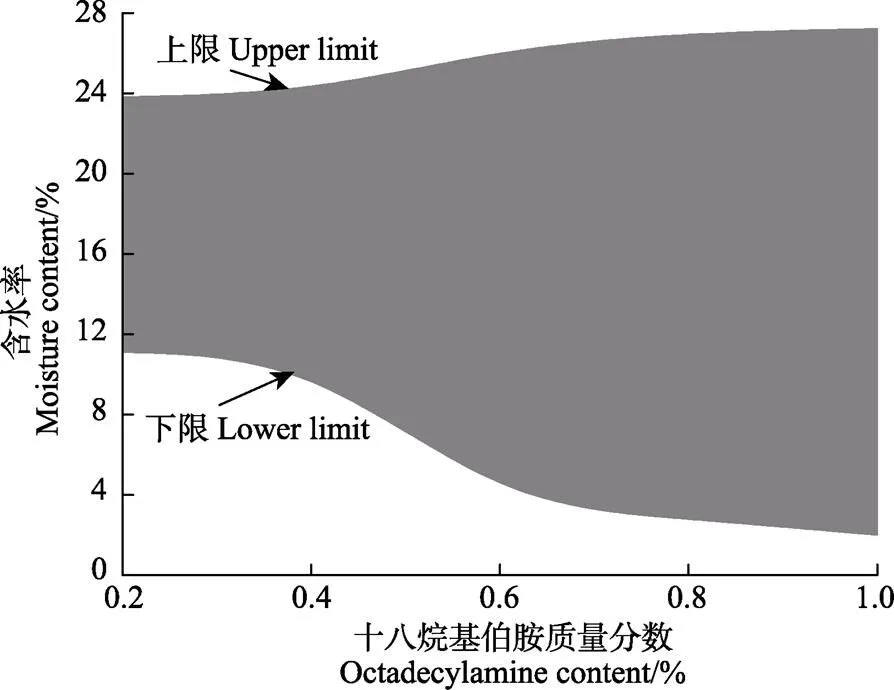
图3 壤土临界含水率与十八烷基伯胺含量关系
2.2 改性土壤对渗流的影响
三轴渗透试验结果包括入渗与出渗。从入渗方面来看,不同水头作用下试样的入渗曲线均表现出典型的双线性,定义为初始入渗阶段和稳定入渗阶段,两线性段交点横坐标定义为突变历时。据此可获得初始入渗速率和稳定入渗速率。
图4为不同改性壤土的渗流流量与时间关系曲线,包括入渗流量(通过水压穿透试样,试样从非饱和至饱和破坏阶段总入渗水体积)与出渗流量(水穿过试样总出渗水体积)。除了极度斥水的试样外,其余试样的入渗曲线均呈现典型的双线性阶段:初始入渗阶段和稳定入渗阶段,两直线交点时间为突变所需历时。相应的初始入渗速率和稳定入渗速率见表2。结果表明,斥水等级相同时,水头差对初始入渗速率影响不明显,如十八烷基伯胺质量分数为0.6%时,20、40和60 kPa水头差初始入渗速率分别为0.210、0.208和0.238 cm/s,相差不大。入渗持续一段时间后,入渗速率突然降低,对应十八烷基伯胺质量分数为0.6%的初始入渗速率分别降至0.005、0.004和0.010 cm/s,进入稳定入渗阶段。相同斥水等级下的稳定入渗速率皆随着水头差增大而增大,随着壤土从无斥水等级到极度斥水等级,其稳定入渗速率呈下降趋势,表明斥水性越强的壤土阻渗效果越明显,水越难以入渗壤土。水头差越大,突变所需历时越长,如对应的十八烷基伯胺质量分数为0.6%的水头差历时分别为10.3、13.8和16.3 min,相应的入渗量也随着水头差的增大而增大。
从出渗上看,其变化规律与入渗流量的基本一致,同一时刻下的数值比入渗流量要小,到稳定渗流阶段时,出渗速率与入渗速率基本相同。不同水头差作用下出渗流量存在水平线段。由于试样初始状态为非饱和,入渗开始阶段,水在短时间内快速充填试样内部孔隙;当入渗流量达到一定值时,试样趋于饱和,多余水量经排水管流出,试样处于稳定渗流阶段。起始出渗时间随水头差的增大而缩短,随斥水等级的增大而增大,其中当壤土为极度斥水时,20 kPa水头差作用时入渗流量不增反减,未测得出渗流量(图4f, 出渗20 kPa为一段水平直线),表明水已无法入渗试样,具备抵抗一定水头作用下入渗的能力。
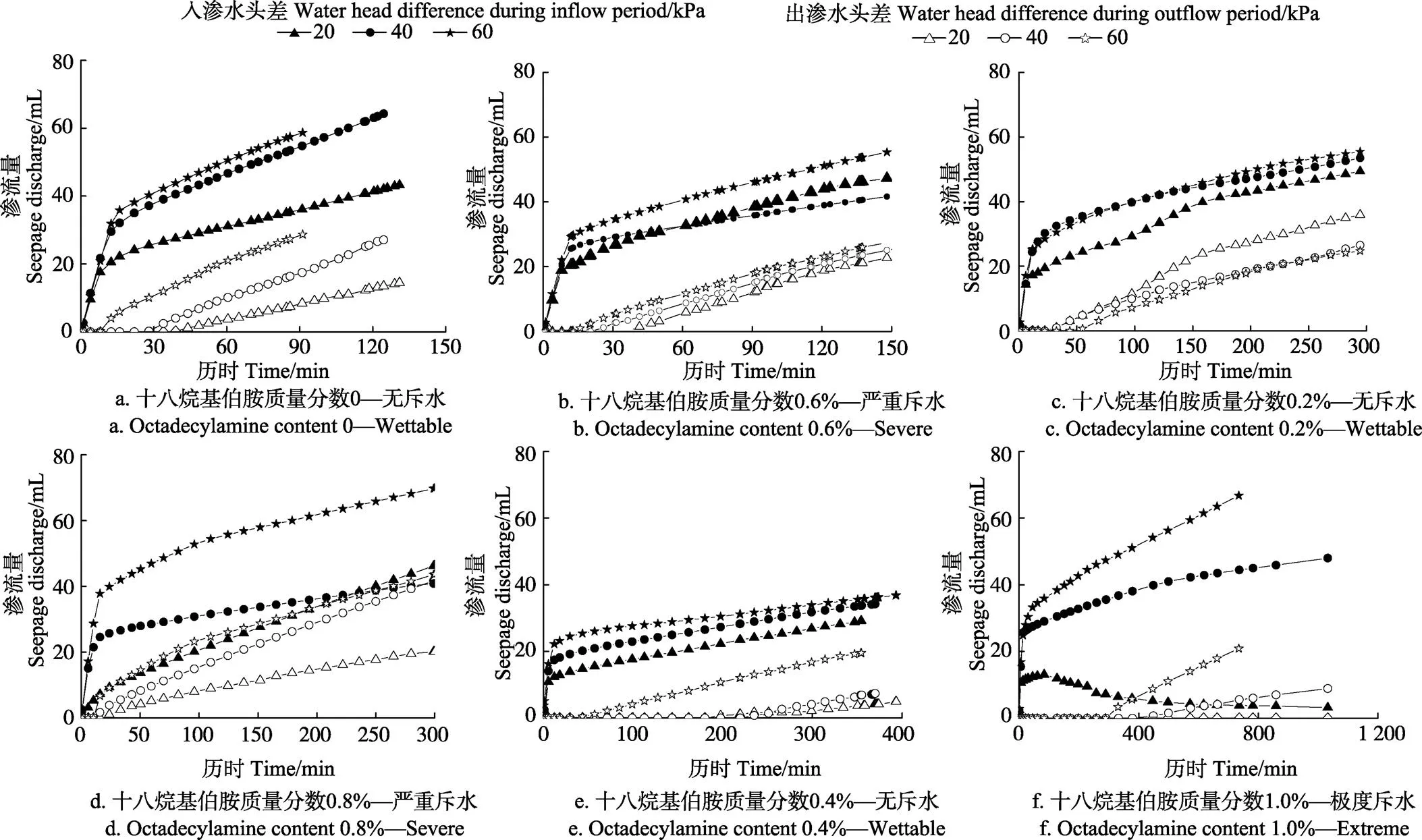
图4 不同斥水等级的壤土渗流量与时间关系

表2 不同斥水等级和水头差作用下壤土初始和稳定入渗速率
2.3 对改性土壤稳定入渗率的影响
将不同水头差作用下壤土的稳定入渗率与十八烷基伯胺含量关系绘于图5中。可以看出,随着十八烷基伯胺含量的增加,稳定入渗率均呈下降趋势。水头差越小,下降幅度越明显。十八烷基伯胺质量分数较低时(0、0.2%和0.4%),稳定入渗率受水头差影响较大:水头差越大,稳定入渗率越小。十八烷基伯胺质量分数达到一定值时(0.6%、0.8%和1.0%),稳定入渗率基本不受水头差的影响。渗流过程中,水对土颗粒会产生渗透力,渗透阻力主要来自固体颗粒及孔隙大小,其与水力梯度成正比。渗径长度相同时,水头差越大,相应的渗透力越大,其对土壤内部结构的挤密作用越明显,导致孔隙体积越小,入渗性能下降。因此当十八烷基伯胺含量较低时,水头差对土壤入渗性能起主导作用;当十八烷基伯胺含量逐渐增加时,十八烷基伯胺对水的排斥作用明显增强,甚至起绝对主导作用,此时水头差对土壤入渗性能影响不明显。对土木水利工程而言,在满足相同密实度的前提下,土壤稳定入渗率越小,工程防渗效果越好,传统防渗措施可大大减少,降低工程造价。就本试验结果而言,十八烷基伯胺质量分数为0.8%的壤土,其在60 kPa水头差作用下的稳定入渗率为7.4×10-5cm/s,已属于极低透水性级别,完全满足工程防渗需要。

图5 不同水头差下壤土稳定入渗率与十八烷基伯胺含量关系
3 结 论
本文采用斥水剂来处理亲水性土壤以降低其渗透性能,既能提升防渗效果,又能减少其他防渗材料使用,降低成本。主要结论如下:
1)十八烷基伯胺含量和土壤含水率是影响土壤斥水性的重要因素。十八烷基伯胺含量越大,土壤斥水性越强。随着斥水等级的提高,斥水土壤上限含水率增加,而下限含水率降低,整个斥水范围不断增大。
2)斥水等级相同时,初始入渗速率受水头差影响较小;土壤从无斥水等级到极度斥水等级,其稳定入渗速率逐渐下降,且起始出渗时间随水头差的增大而缩短。
3)随着斥水等级的增加,稳定入渗率均呈下降趋势。水头差越小,下降幅度越明显。水头差越大,稳定入渗率越小。斥水等级为极度时,稳定入渗率基本不受水头差的影响。
4)十八烷基伯胺质量分数为0.8%的壤土,在60 kPa水头差作用下的稳定入渗率为7.4×10-5cm/s,已达到低透水性级别,完全满足工程防渗需要。
[1] Fredlund D G, Morgenstern N R. Stress state variables for unsaturated soils[J]. Journal of Geotechnical Engineering Division, 1977, 103: 447-466.
[2] 王中平,孙振平,金明. 表面物理化学[M]. 上海:同济大学出版社,2015.
[3] 李毅,商艳玲,李振华,等.土壤斥水性研究进展[J].农业机械学报,2012,43(1):68-75. Li Yi, Shang Yanling, Li Zhenhua, et al. Advance of study on soil water repellency[J]. Transactions of the Chinese Society for Agricultural Machinery, 2012, 43(1): 68-75. (in Chinese with English abstract)
[4] Debano L F. Water repellency in soils: A historical overview[J]. Journal of Hydrology, 2000, 231/232: 4-32.
[5] Doerr S H, Shakesby R A, Walsh R P D. Soil water repellency: Its causes, characteristics and hydro-geomorphological significance[J]. Earth-Science Reviews, 2000, 51(1/2/3/4): 33-65.
[6] Doerr S H, Ferreira A J D, Walsh R P D, et al. Soil water repellency as a potential parameter in rainfall-runoff modeling: Experimental evidence at point to catchment scales from portugal[J]. Hydrological Process, 2003, 17(2): 363-377.
[7] Bauters T W J, Dicarlo D A, Steenhuis T S, et al.. Preferential flow in water-repellent sands[J]. Soil Science Society of America Journal, 1998, 62(5): 1185-1190.
[8] 刘春成,李毅,郭丽俊,等微咸水灌溉对斥水土壤水盐运移的影响[J]. 农业工程学报,2011,27(8):39-45. Liu Chuncheng, Li Yi, Guo Lijun, et al. Effect of brackish water irrigation on water and salt movement in repellent soils[J]. Transactions of the Chinese Society of Agricultural Engineering (Transactions of the CSAE), 2011, 27(8): 39-45. (in Chinese with English abstract)
[9] 李柏贞,周广胜. 干旱指标研究进展[J]. 生态学报,2014, 34(5):1043-1052. Li Baizhen, Zhou Guangsheng. Advance in study on drought index[J]. Acta Ecologica Sinica, 2014, 34(5): 1043-1052. (in Chinese with English abstract)
[10] Coles N, Trudgill S. The movement of nitrogen fertilizer from the soil surface to drainage waters by preferential flow in weakly structured soils[J]. Agriculture Ecosystems and Environment, 1985, 13: 241-259.
[11] 毛昶熙. 管涌与滤层的研究:管涌部分[J]. 岩土力学,2005,26(2):209-215. Mao Changxi. Study on piping and filters: Part I of piging[J]. Rock and Soil Mechanics, 2005, 26(2): 209-215. (in Chinese with English abstract)
[12] 施成华,彭立敏. 基坑开挖及降水引起的地表沉降预测[J].土木工程学报,2006,39(5):117-121. Shi Chenghua, Peng Limin. Ground surface settlement caused by foundation pit excavation and dewatering[J] China Civil Engineering Journal, 2006, 39(5): 117-121. (in Chinese with English abstract)
[13] 汪益敏,陈页开,韩大建,等. 降雨入渗对边坡稳定影响的实例分析[J]. 岩石力学与工程学报,2004,23(6):920-924. Wang Yimin, Chen Yekai, Han Dajian, et al. Case study on influence of rainfall permeation on slope stability[J]. Chinese Journal of Rock Mechanics and Engineering, 2004, 23(6): 920-924. (in Chinese with English abstract)
[14] 陈生水,钟启明,陶建基. 土石坝溃决模拟及水流计算研究进展[J]. 水科学进展,2008,19(6):903-910. Chen Shengshui, Zhong Qiming, Tao Jianji. Development in embankment dam break simulation and water flow simulation[J]. Advances in Water Science, 2008, 19(6): 903-910. (in Chinese with English abstract)
[15] 杨蕴,吴剑锋,林锦,等. 控制海水入侵的地下水多目标模拟优化管理模型[J]. 水科学进展,2015,26(4):579-588. Yang Yun, Wu Jianfeng, Lin Jin, et al. A multi-objective simulation-optimization model constrained by the potential seawater intrusion[J]. Advances in Water Science, 2015, 26(4): 579-588. (in Chinese with English abstract)
[16] 叶为民,金麒,黄雨. 地下水污染试验研究进展[J].水利学报,2005,36(2):251-255. Ye Weimin, Jin Qi, Huang Yu. Review on advance in experimental study of pollution dispersion in groundwater[J]. Journal of Hydraulic Engineering, 2005, 36(2): 251-255. (in Chinese with English abstract)
[17] Deurer M, Bachmann J. Modeling water movement in heterogeneous water repellent soil: 2. A conceptual numerical simulation[J]. Vadose Zone Journal, 2007, 6(3): 446-457.
[18] Fredlund D G, Xing A. Equations for the soil-water characteristic curve[J]. Canadian Geotechnical Journal, 1994, 31(3): 521-532.
[19] 王景明,王珂,郑咏梅,等. 荷叶表面纳米结构与浸润性的关系[J].高等学校化学学报,2010,31(8):1596-1599. Wang Jingming, Wang Ke, Zheng Yongmei, et al. Effects of chemical composition and nano-structures on the wetting behaviour of lotus leaves[J]. Chemical Journal of Chinese Universities, 2010, 31(8): 1596-1599. (in Chinese with English abstract)
[20] Lee W, Jin M K, Yoo W C, et al. Nanostructuring of a polymeric substrate with well-defined nanometer scale topography and tailored surface wettability[J]. Langmuir, 2004, 20(18): 7665-7669.
[21] 徐先锋,刘烁,洪龙龙. 非金属超疏水材料的制备方法及研究进展[J]. 中国塑料,2013,27(5):12-18. Xu Xianfeng, Liu Shuo, Hong Longlong. Preparation and developments of non-metal superhydrophobic materials[J]. China Plastics, 2013, 27(5): 12-18. (in Chinese with English abstract)
[22] 杨松,龚爱民,吴珺华,等. 接触角对非饱和土中基质吸力的影响[J].岩土力学,2015,36(3):674-678. Yang Song, Gong Aimin, Wu Junhua, et al. Effect of contact angle on matric suction of unsaturated soil[J]. Rock and Soil Mechanics, 2015, 36(3): 674-678. (in Chinese with English abstract)
[23] 吴珺华,周晓宇,林辉,等. 不同斥水剂作用下土壤斥水度测定及其变化规律[J]. 农业工程学报,2018,34(17):109-115.Wu Junhua, Zhou Xiaoyu, Lin Hui, et al. Hydrophobic degree measurement and its changes in soils modified by different hydrophobic agents[J]. Transactions of the Chinese Society of Agricultural Engineering (Transactions of the CSAE), 2018, 34(17): 109-115. (in Chinese with English abstract)
[24] 吴珺华,林辉,周晓宇,等. 斥水剂作用下非饱和土壤抗剪强度测定及其变化规律[J]. 农业工程学报,2019,35(6):123-129. Wu Junhua, Lin Hui, Zhou Xiaoyu, et al. Measurement of shear strength and its change in unsaturated soils modified by hydrophobic agent[J]. Transactions of the Chinese Society of Agricultural Engineering (Transactions of the CSAE), 2019, 35(6): 123-129. (in Chinese with English abstract)
[25] 刘清秉,项伟,张伟锋,等. 离子土壤固化剂改性膨胀土的试验研究[J].岩土力学,2009,30(8):2286-2290. Liu Qingbing, Xiang Wei, Zhang Weifeng, et al. Experimental study of ionic soil stabilizer-improves expansive soil[J]. Rock and Soil Mechanics, 2009, 30(8): 2286-2290. (in Chinese with English abstract)
[26] Roper M M. The isolation and characterisation of bacteria with the potential to degrade waxes that cause water repellency in sandy soils[J]. Australian Journal of Soil Research, 2004, 42(4): 427-434.
[27] Franco C M M, Tate M E, Oades J M. Studies on non-wetting sands: I. The role of intrinsic particulate organic matter in the development of water repellency in non-wetting sands[J]. Australian Journal of Soil Research, 1995, 33(2): 253-263.
[28] 周芳琴,罗鸿禧.微生物对某些岩土工程性质的影响[J]. 岩土力学,1997,18(2):17-22. Zhou Fangqin, Luo Hongxi. The effect of microbes on some geotechnical engineering properties[J]. Rock and Soil Mechanics, 1997, 18(2): 17-22. (in Chinese with English abstract)
[29] 杨松,黄剑峰,罗茂泉,等. 斥水性砂土水-气形态及其对斥水-亲水转化的影响分析[J]. 农业机械学报,2017,48(11):247-252. Yang Song, Huang Jianfeng, Luo Maoquan, et al. Pore water-air configurations in water repellent sandy soil and its effects on transformation of hydrophilicity to hydrophobicity[J]. Transactions of the Chinese Society for Agricultural Machinery, 2017, 48(11): 247-252. (in Chinese with English abstract)
[30] Dekker L W, Ritsema C J. Wetting patterns and moisture variability in water repellent Dutch soils[J]. Journal of Hydrology, 2000, 231/232: 148-164.
[31] Liu H, Ju Z, Bachmann J, et al. Moisture dependent wettability of artificial hydrophobic soils and its relevance for soil water desorption curves[J]. Soil Science Society of America Journal, 2012, 76(2): 342-349.
[32] Liu Chang, Chen Junying, Zhang Lin, et al. Effect of initial soil moisture content on infiltration characteristics of water-repellent clay loam[J]. Journal of Drainage and Irrigation Machinery Engineering, 2018, 36(4): 354-361.
[33] Woudt B D V. Particle coatings affecting the wettability of soils[J]. Journal of Geophysical Research Atmospheres, 1959, 64(2): 263-267.
[34] Jordan A, Zavala L M, Nava A L, et al. Occurrence and hydrological effects of water repellency in different soil and land use types in Mexican volcanic highlands[J]. Catena, 2009, 79(1): 60-71.
[35] Li Xu, Wang Ziru, Yang Li, et al. Synthesis and performance of magnetic oil absorption material with rice chaff support[J]. Materials Review B: Research, 2018, 32(1): 219-222, 227.
[36] Nyman P, Sheridan G J, Smith H G, et al. Modeling the effects of surface storage, macropore flow and water repellency on infiltration after wildfire[J]. Journal of hydrology, 2014, 513: 301-313.
[37] Li Yi, Wang Xiaofang, Cao Zhenkai, et al. Soil water repellency characteristic curve influenced by drying and wetting processes[J]. Canadian Journal of Soil Science, 2017, 97: 226-240.
[38] 陈俊英,吴普特,张智韬,等. 土壤斥水性对含水率的响应模型研究[J]. 农业机械学报,2012,43(1):63-67Chen Junying, Wu Pute, Zhang Zhitao, et al. Response Models for soil water repellency and soil moisture[J]. Transactions of the Chinese Society for Agricultural Machinery, 2012, 43(1): 63-67. (in Chinese with English abstract)
Hydrophobility and infiltration properties of loam chemically modified by octadecylamine
Wu Junhua1, Lin Hui1, Liu Jiaming1, Wang Maosheng1, Yang Song2※
(1.330063,2650201,)
This study aimed to analyze water repellency and infiltration performance of soils with octadecylamine addition. Air-dried remolded loam was mixed with octadecylamine to obtain water repellent loam. A total 5 kinds of loam with octadecylamine content of 0.2%, 0.4%, 0.6%, 0.8% and 1.0% were prepared. For each loam with a certain octadecylamine content, 16 samples with different initial moisture content were then prepared. The water repelling of water repellent loam was determined by water drop penetration time (WDPT), and the critical moisture content of water repellent loam was proposed. Then the permeability tests of water repellent loam under different water head differences were carried out by using a triaxial permeameter. The relationship between octadecylamine content, seepage discharge and water head differences was analyzed, and the permeability coefficient of water repellent loam was obtained. The octadecylamine and soil moisture content were important factors affecting soil water repellency and the higher octadecylamine mass fractions had the stronger water repellency of loam, the lower moisture content of upper limit, and the higher moisture content of lower limit. When the moisture content was less than 12%, the drop penetration time of loam with octadecylamine content of 0.2% and 0.4% was less than 5 s, which showed hydrophilicity. When the moisture content of loam increased to 21%, the drop penetration time of loam increased rapidly to 3 611 and 4 012 s, respectively. That means the corresponding water repelling of loam changed from hydrophilicity to extreme level. The drop penetration time of loam soil with moisture content between 21% and 25% was more than 3 600s, which showed extreme level. When the moisture content increased from 25% to 32% (saturation), the water repellency of loam decreased rapidly from extreme to hydrophilicity. In loam with natural air-dried moisture content, the drop penetration time of loam with octadecylamine content of 0.6% and 0.8% were 731 s and 2 584 s, which showed severe level. With the increasing of moisture content, the drop penetration time increased rapidly to 9 345 s (moisture content of 23.1%) and 12 364 s (moisture content of 21.6%), which showed extreme levels. Then the drop penetration time decreased rapidly and the water repellency disappeared completely at saturation. The drop penetration time of natural air-dried loam was 4 886 s with octadecylamine content of 1.0%, which showed extreme level. With the increasing of moisture content, the drop penetration time also increased rapidly. The maximums of drop penetration time were more than 18 000s (moisture content of 19.3%, 20.0% and 23.7%) which showed extreme levels. When the moisture content increased to 26.8%, the drop penetration time decreased rapidly to 9 346 s, and the water repellency disappeared completely at saturation. For loam with octadecylamine content of 0.2% and 0.4%, the upper limits of moisture content were 11.1% and 10.8%, and the lower limits of moisture content were 23.9% and 24.1%, respectively. For loam with octadecylamine contents of 0.6%, 0.8% and 1.0%, the upper limits of moisture content were 3.5%, 2.8% and 2.0%, and the lower limits of moisture content were 26.3%, 27.1% and 27.3%, respectively. When the octadecylamine content were the same, the initial infiltration rates was less affected by water head differences. After a period of time, the infiltration rates were decreased suddenly and kept stable. The larger water head differences had the higher stable infiltration rates. When the water repellency of soils changed from wettable to extreme level, the stable infiltration rate gradually decreased. The mutation time of infiltration was shortened with the increasing of water head differences. When the octadecylamine content were low (0%, 0.2% and 0.4%), the permeability coefficients were greatly affected by the water head differences: the greater the water head differences had the smaller permeability coefficients. When the octadecylamine content were high (0.6%, 0.8% and 1.0%), the permeability coefficients were basically not affected by the water head differences. When the octadecylamine content was 0.8% and the water head difference was 20 kPa, the water hardly infiltrated into loam which showed complete impermeability. The results can provide theoretical support to analysis on hydrophobized soil and its application in civil and hydraulic engineering.
soils; permeability; moisture; water repellent; octadecylamine
10.11975/j.issn.1002-6819.2019.13.013
S152.+7
A
1002-6819(2019)-13-0122-07
2018-11-23
2019-05-11
国家自然科学基金项目(51869013、41867038);江西省自然科学基金项目(20181BAB216033);江西省教育厅科技项目(GJJ180530);南昌航空大学研究生创新基金项目(YC2018070)
吴珺华,副教授,博士,主要从事非饱和土基本性质研究。Email:wjhnchu0791@126.com
杨 松,副教授,博士,主要从事非饱和土基本性质研究。Email:yscliff007@126.com
吴珺华,林 辉,刘嘉铭,王茂胜,杨 松.十八胺化学改性下壤土的斥水性与入渗性能研究[J]. 农业工程学报,2019,35(13):122-128. doi:10.11975/j.issn.1002-6819.2019.13.013 http://www.tcsae.org
Wu Junhua, Lin Hui, Liu Jiaming, Wang Maosheng, Yang Song. Hydrophobility and infiltration properties of loam chemically modified by octadecylamine[J]. Transactions of the Chinese Society of Agricultural Engineering (Transactions of the CSAE),2019, 35(13): 122-128. (in Chinese with English abstract) doi:10.11975/j.issn.1002-6819.2019.13.013 http://www.tcsae.org
